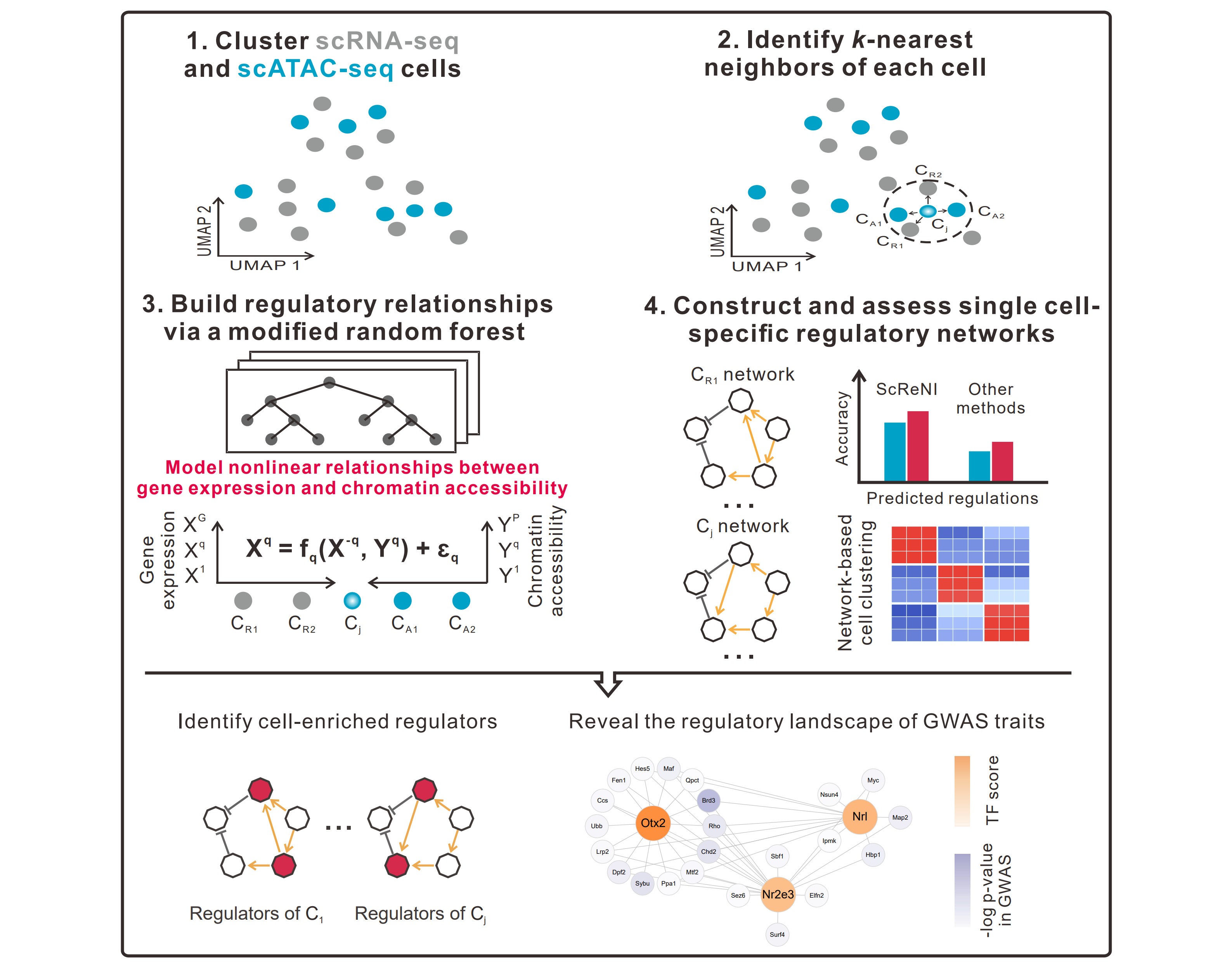ScReNI for Cell-specific Regulatory Network Inference
A research team led by Prof. WANG Jie from the Guangzhou Institutes of Biomedicine and Health, Chinese Academy of Sciences, in collaboration with Prof. LI Yixue from Guangzhou National Laboratory, developed a new computational tool ScReNI to infer gene regulatory networks at the single-cell level. This method facilitates the inferences of cell-specific regulatory networks and cell-enriched regulators, providing insights into single-cell regulatory mechanisms of diverse biological processes. The findings were published in Genomics, Proteomics & Bioinformatics.
Transcriptional regulatory networks play a key role in determining gene expression patterns in individual cells. The advent of single-cell sequencing technologies has paved the way for single-cell RNA sequencing (scRNA-seq) and single-cell ATAC sequencing (scATAC-seq), providing unparalleled resolution for the study of gene regulation at a cellular level. These techniques provide valuable insights into the transcriptomic and epigenomic landscapes, facilitating the accurate inference of regulatory networks. However, integrating scRNA-seq and scATAC-seq data, especially when the datasets are unpaired, remains a major challenge.
To address this challenge, we present ScReNI (Single-Cell Regulatory Network Inference) , a new computational framework for inferring cell-specific regulatory networks from paired or unpaired scRNA-seq and scATAC-seq data. ScReNI first aligns the two data types in a shared analytical space, enabling integration even without matched cells. It then links genes to regulatory peaks using genomic proximity and transcription factor motif analysis.
A key feature of ScReNI is its use of neighbouring cell information to model local regulatory contexts. By combining k-nearest neighbours and random forest algorithms, it captures non-linear relationships between chromatin accessibility and gene expression, building personalised regulatory networks at single-cell resolution. Evaluation shows ScReNI outperforms existing methods in predicting regulatory interactions and refining cell clusters. It also identifies key regulatory factors specific to each cell, offering novel insights into gene regulation.
ScReNI advances single-cell genomics by enabling accurate inference of regulatory networks and systematic identification of cell-specific regulators. As a robust and flexible computational framework, it improves the precision of gene regulatory predictions and captures dynamic regulatory mechanisms underlying complex biological processes such as development, differentiation, and disease progression.
XU Xueli, LIANG Yanran, and TANG Miaoxiu from the Guangzhou Institutes of Biomedicine and Health, Chinese Academy of Sciences, are co-first authors of this study. Prof. LI Yixue from Guangzhou National Laboratory and Prof. WANG Jie from the Guangzhou Institutes of Biomedicine and Health are co-corresponding authors. This study was supported by the National Natural Science Foundation of China, National Key Research and Development Program of China, and the Science and Technology Planning Project of Guangdong Province.

Figure: Overview of ScReNI (Image by Prof. WANG's team).
Contacts:
WANG Jie, Ph.D., Principal Investigator;
Guangzhou Institutes of Biomedicine and Health, Chinese Academy of Sciences, Guangzhou, China, 510530.
Email: wang_jie01@gibh.ac.cn
Attachment Download:
-
ContactWANG Jie, Ph.D., Principal Investigatorwang_jie01@gibh.ac.cn
-
ReferenceGuangzhou Institutes of Biomedicine and Health, Chinese Academy of Sciences" id="doi" target="_blank" class="xl-r-article">WANG Jie
-
Related Article